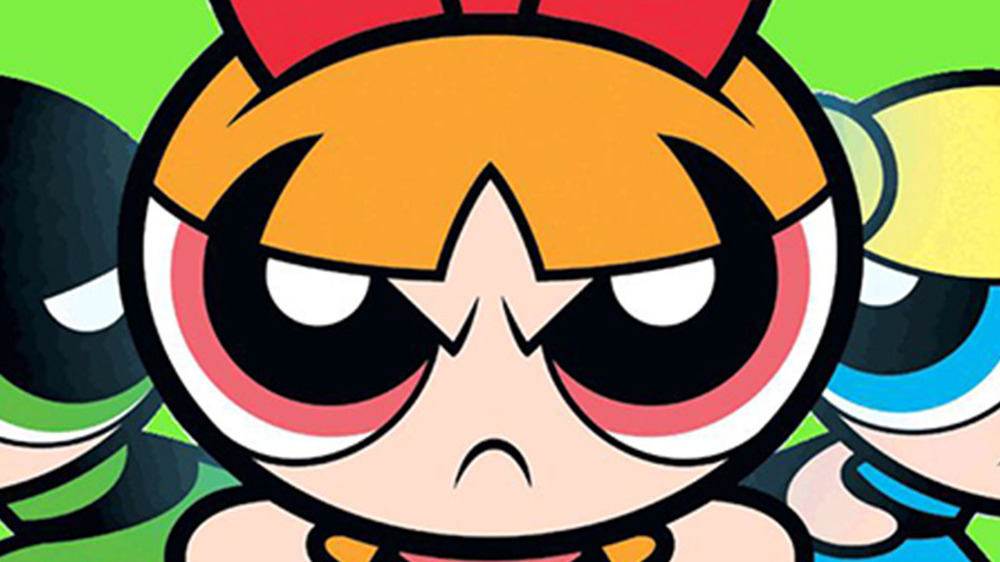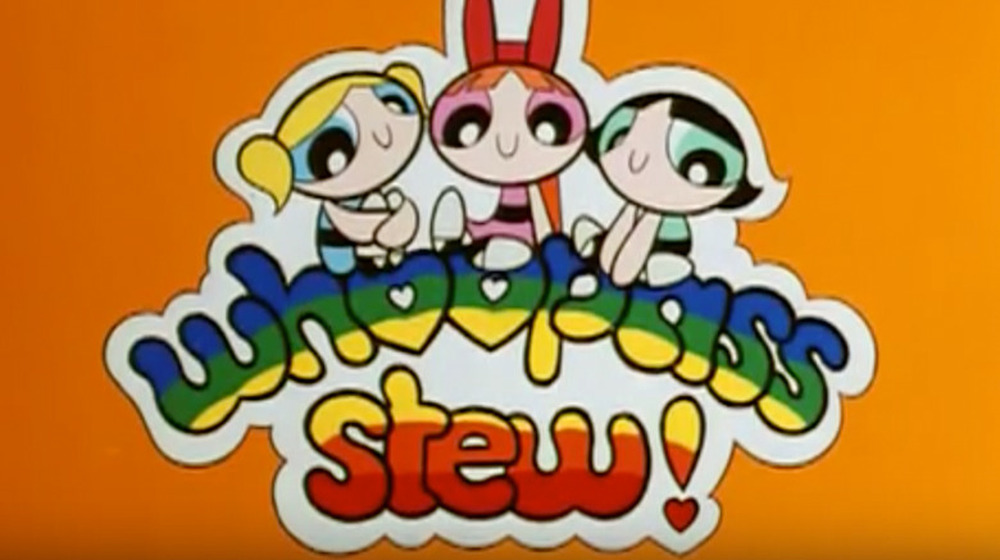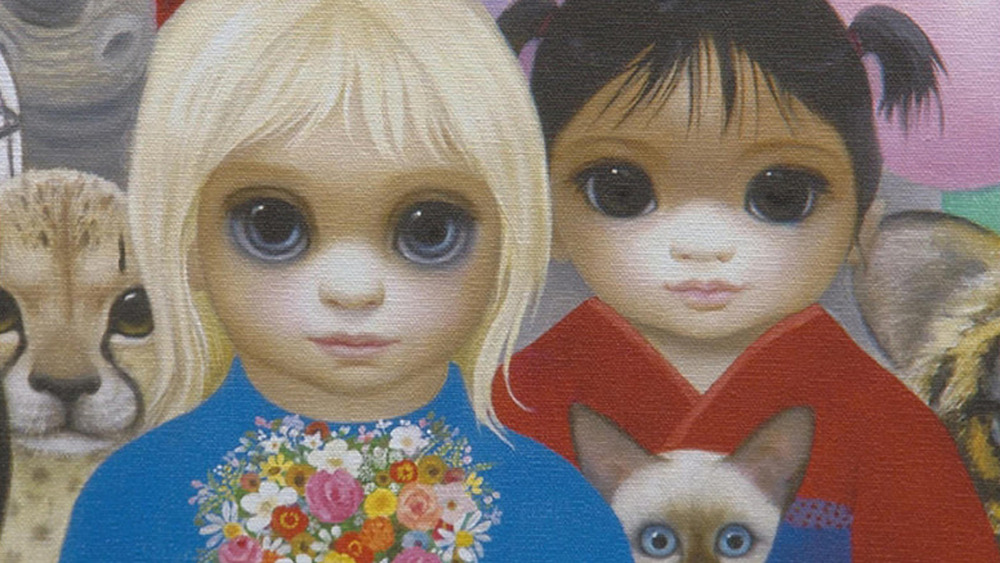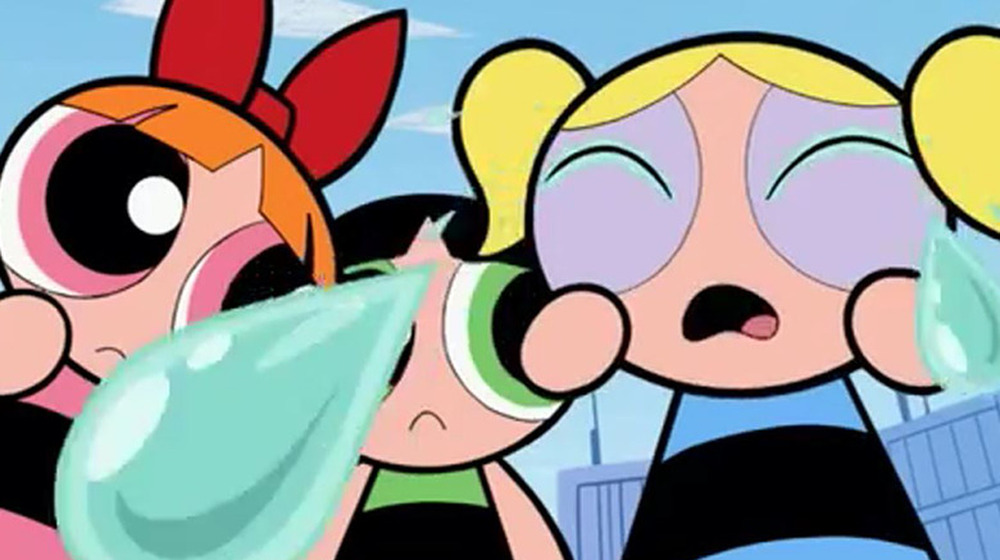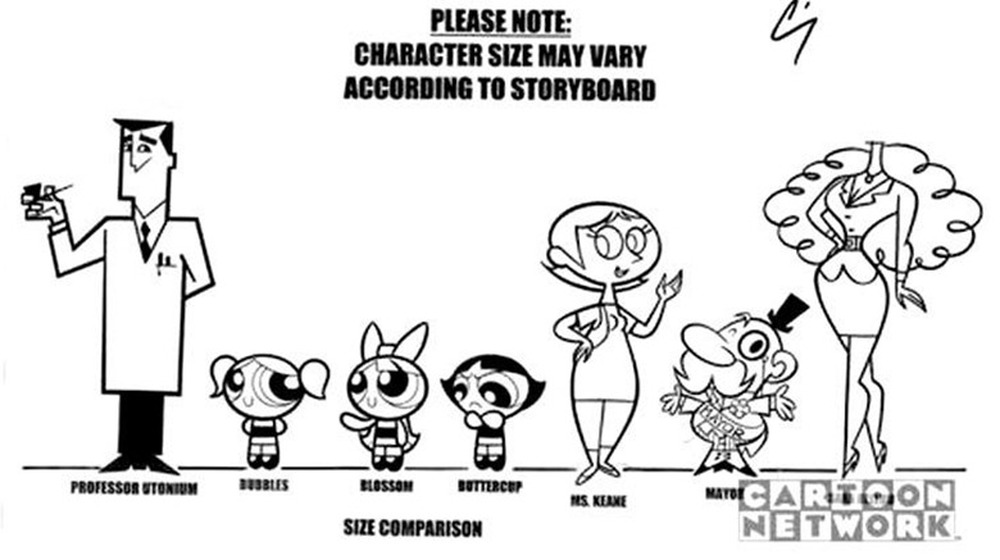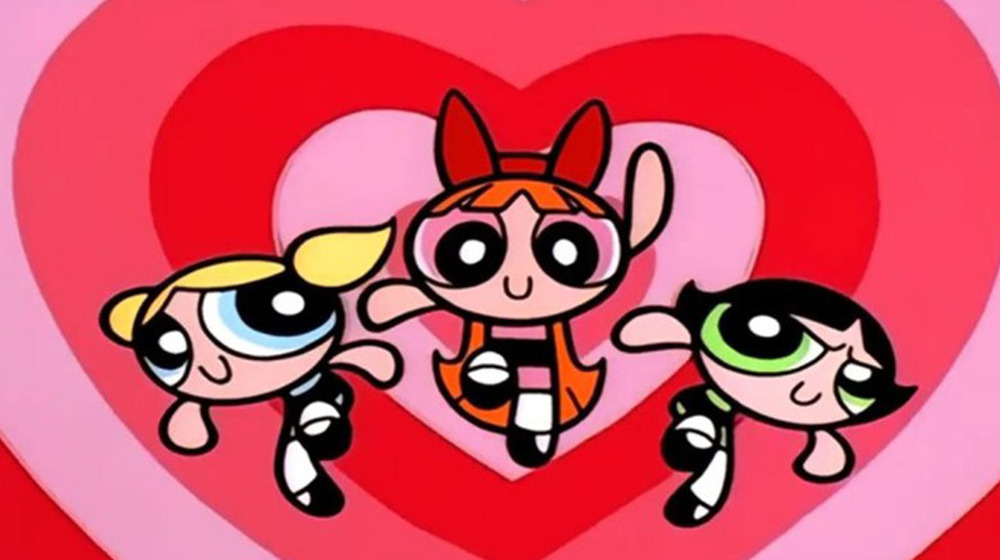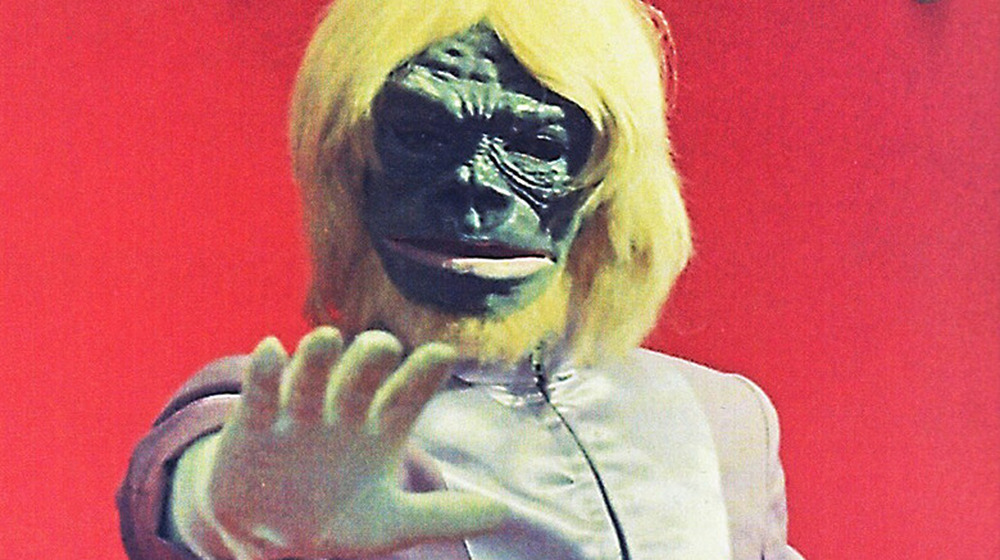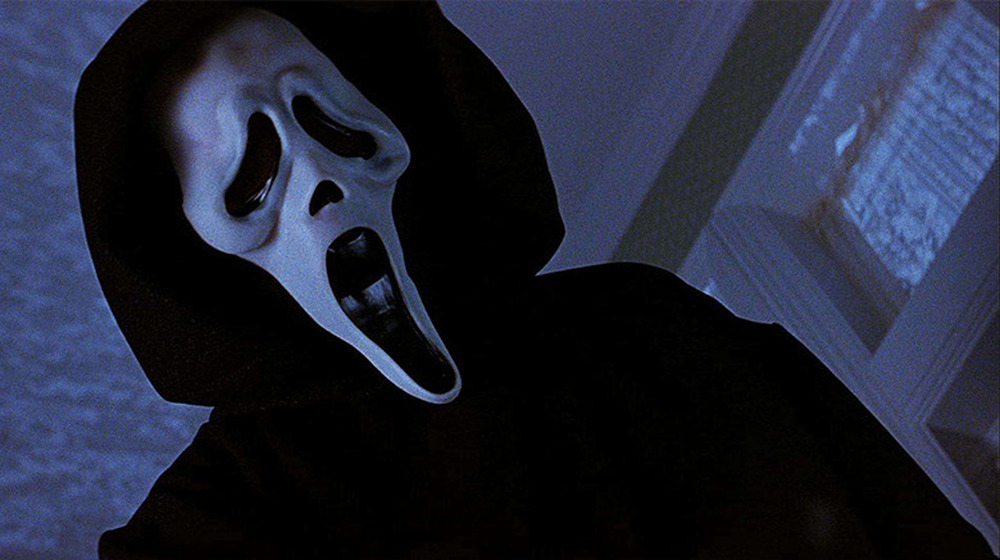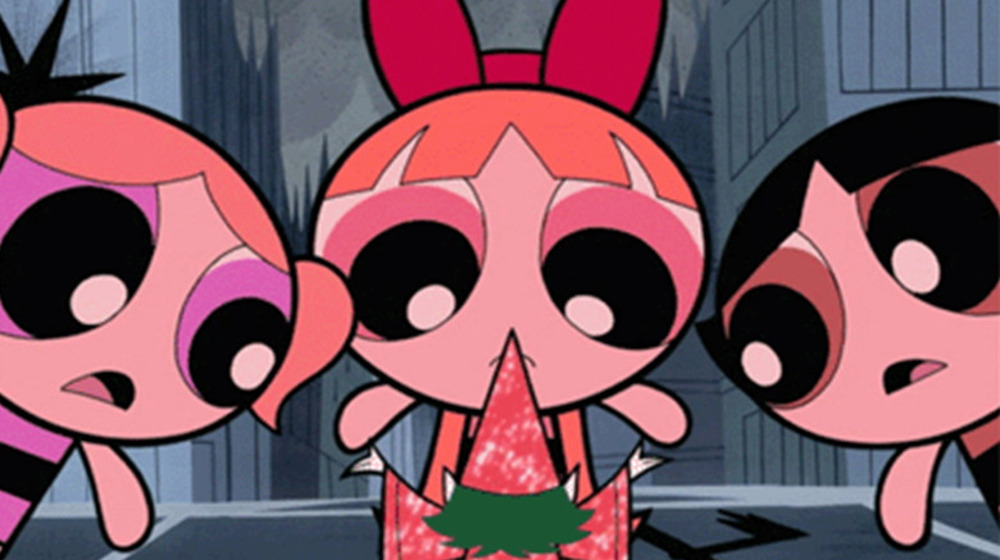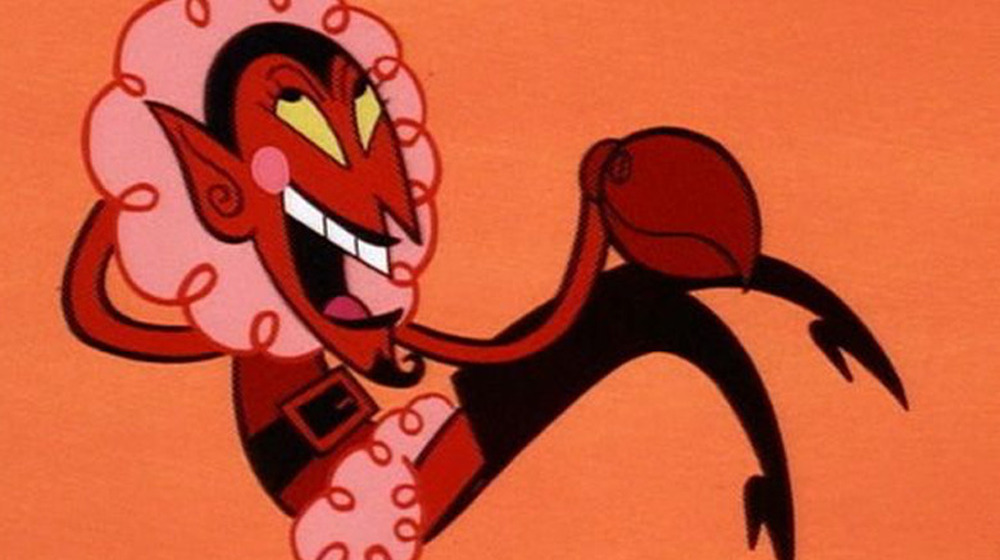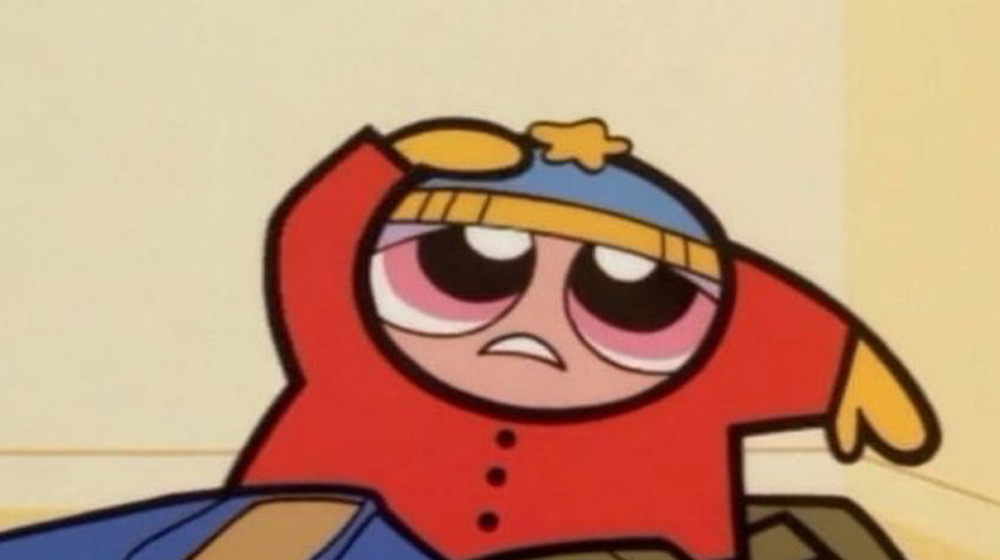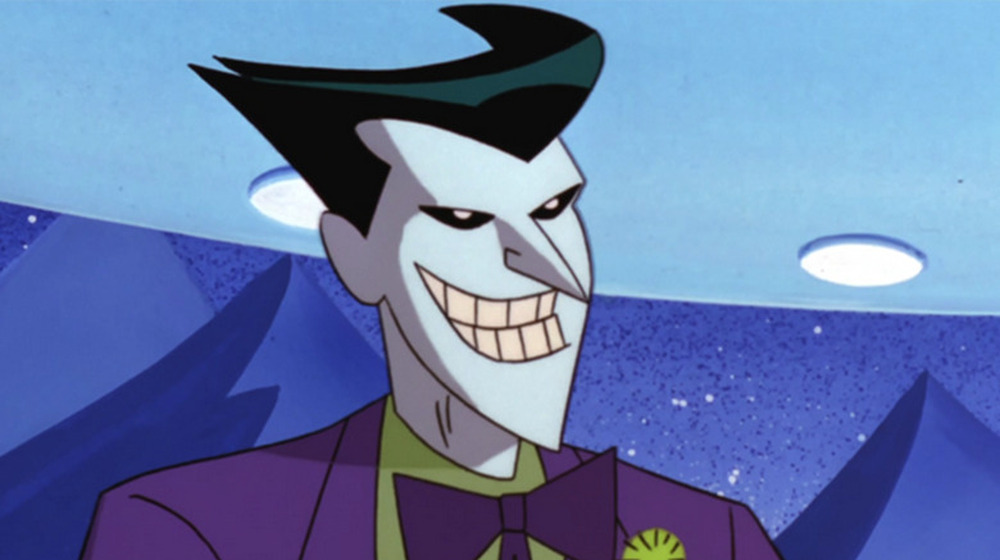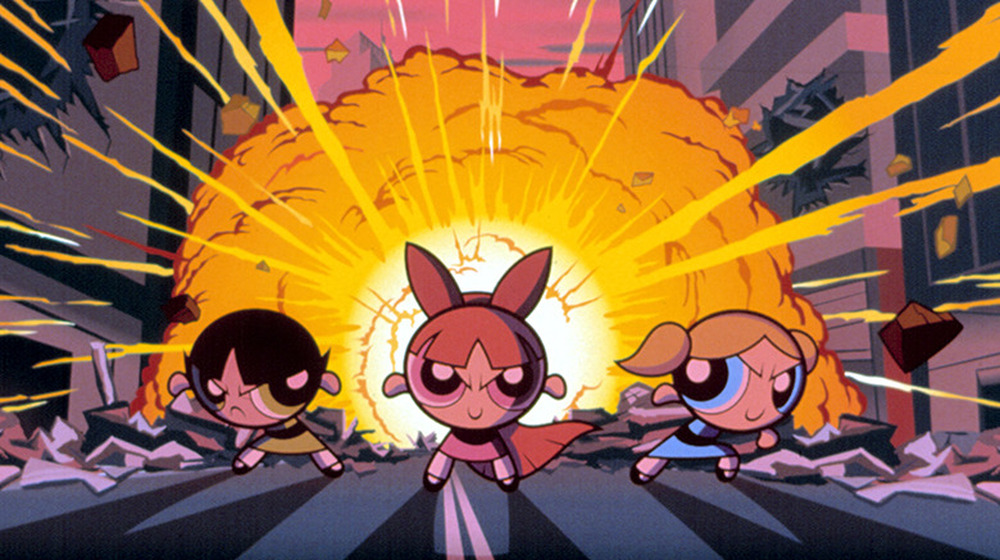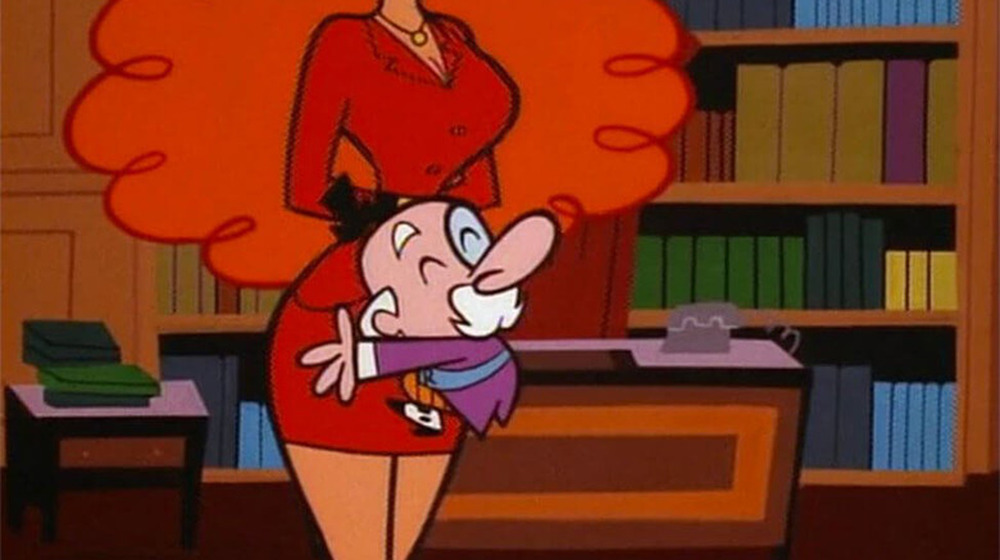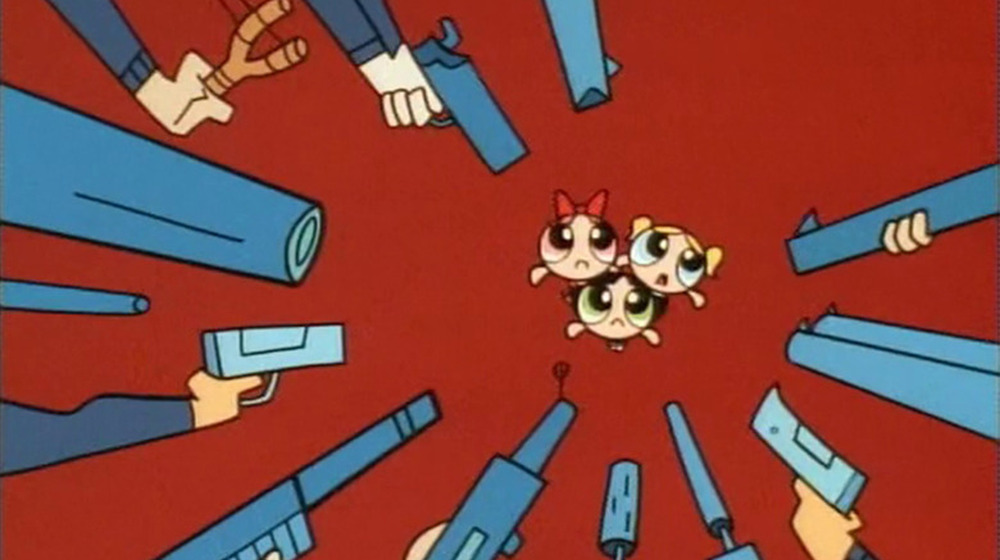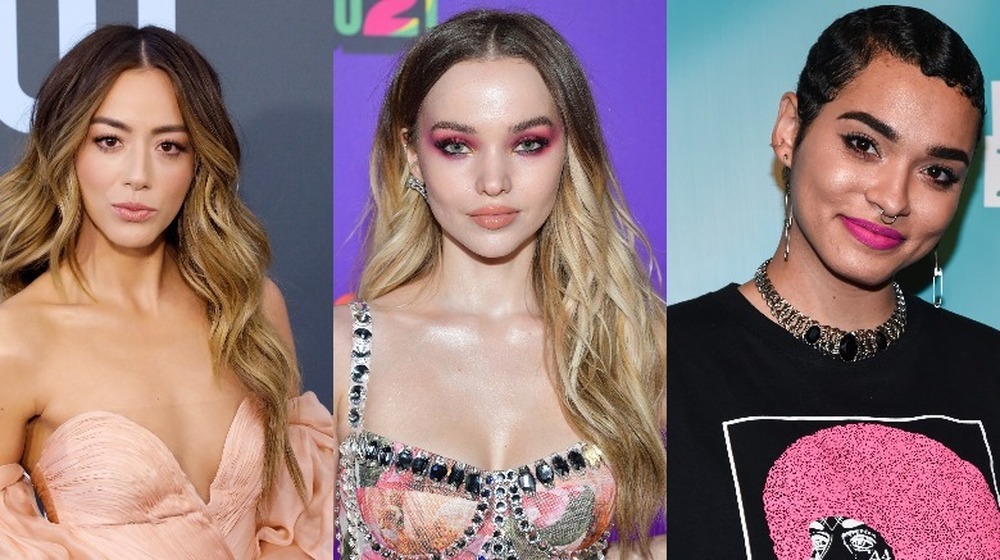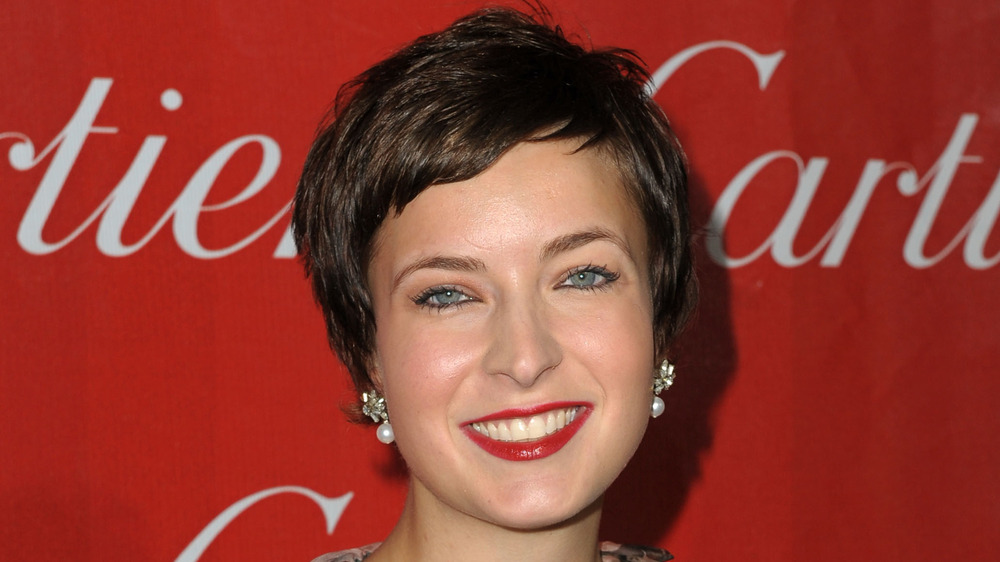The Untold Truth Of The Powerpuff Girls
Want to create a cartoon classic? Just take some old superhero comics, giant anime robots, science fiction aliens, gross violence and Hanna-Barbera cartoons, toss them in a blender and hit puree. The result is sugar, spice, everything nice and an accidental fourth ingredient, Chemical X. From 1998-2005, that mixture got you Blossom, Bubbles and Buttercup, the three super-powered little girls that starred in the Cartoon Network monster hit The Powerpuff Girls.
The series was the brainchild of animator Craig McCracken and yielded not only the series but several specials, an ocean's worth of merchandise tie-ins, a theatrical feature film, and a reboot in 2016. Proving that you can't keep three good girls down, the CW Network recently announced a gritty live-action reimagining, aiming to hit the airwaves next year.
The original show was unique in that many little girls were attracted to the bright sugary colors and cute designs, boys liked the overtly violent action sequences, and grownups enjoyed the subtle adult humor. To say it was a phenomenon would be an understatement and — alongside shows such as Dexter's Laboratory, Courage the Cowardly Dog and Ed Edd n' Eddy — it helped Cartoon Network define its identity for years to come.
But as popular and well known as The Powerpuff Girls still is, there are some facts, secrets and hidden truths about the franchise that have somehow flown beneath the radar. So, in preparation for the CW Network's gritty reboot, now feels like the perfect time to share some secrets from the City of Townsville.
Their Original Name
As it turns out, one of Cartoon Network's strangest shows only discovered its true identity after McCracken decided against opening a can of Whoopass.
During McCracken's time at animation school CalArts, he created a short film titled Whoopass Stew (aka A Sticky Situation). The short starred the "Whoopass Girls," and get this: the original concept for Chemical X was literally a can labeled "Whoop Ass."
The short was shown during late '80s/early '90s touring staple Spike and Mike's Sick and Twisted Festival of Animation, and in 1992 Cartoon Network took notice of McCracken's work, giving it a slot on What a Cartoon! and then offering him a series. The only caveat, of course, was that the name and any mention of the word ass had to be removed for increased chance of marketability. Keep in mind, this was about a decade before Jackass and two before the Kick-Ass movies.
Obviously, McCracken was making content that he personally enjoyed from the start, injecting what he would personally want to see in a kids' cartoon such as...you know...comic book homages and rampant violence.
So as it turns out, The Powerpuff Girls has a lot in common with shows like Spongebob Squarepants, Ed Edd n Eddy and Avatar the Last Airbender (not to mention Beavis and Butt-Head, a fellow Spike and Mike alumni), all major tentpoles of TV animation that originated from extremely humble beginnings, be it a student short film or just a silly doodle.
Why are their eyes so big?
The original design for the Powerpuff Girls appeared even earlier than Whoopass Stew, and in a rather interesting place: a birthday card.
Before creating his short film, McCracken made a birthday card for his brother which was adorned with the design of three little girls with cartoonishly large eyes. The size of the eyes was inspired by the art of Margaret Keane, most famous for the story surrounding her work — that abusive husband Walter Keane took false credit for the paintings and threatened Margaret into silence.
Margaret would eventually prove in court that she was the one true creator of the big eyed girl paintings, and has gone on to become recognized as one of the most influential artists of the 1960s. This was the subject of the Tim Burton film Big Eyes, where Margaret was portrayed by Amy Adams.
Margaret Keane's place within art history has been immortalized not only through mass publication and dramatization, but through McCracken's tribute in the designs of the girls. The giant eyes, alongside the girl's lack of fingers, went on to become one of the defining, unique visual traits of the franchise's style — which is funny, considering they were not warmly received at first.
The show was not well received in the testing phase
Remember the Season 8 episode of The Simpsons entitled "The Itchy & Scratchy & Poochie Show," where Bart and Lisa were ushered into a focus group to revamp the Itchy & Scratchy cartoon, only to find that every kid had their own crazy and conflicting idea on how to make the show cooler? That is not far off the mark from what the Powerpuff Girls went through before it landed on TV screens in the late '90s. It might be crazy to conceive of now — especially considering the show's legacy and lasting pop cultural significance — but while the series was still in the workshopping phase, several kids were shown early pilot footage and were less than enthused.
Some kids reportedly cited the girls' lack of hands as "disturbing," with one hating it enough to say that McCracken should be fired. Believe it or not, the crisp and clean design that would eventually make the show stand out among the crop of other cartoons airing at the time was nearly its undoing before the show ever aired.
Luckily the network, convinced The Powerpuff Girls would find a fanbase of some kind, opted not to pull the plug. When the series hit the airwaves in 1998, it was an instant sensation.
The show's visual style was unorthodox at the time
We already mentioned the unique design traits — the large eyes and the lack of fingers — but, even after putting those to one side there is a lot about the show's appearance that helped set it apart from not just the other shows on Cartoon Network at the time, but many other cartoons airing on competing channels as well.
The show was perhaps most similar to Dexter's Laboratory — created by Genndy Tartakovsky, a friend of McCracken who'd go on to create the Emmy award winning series Samurai Jack — but in terms of design, both shows were outliers amongst cartoons airing during those years like Cow & Chicken, Rugrats and Courage the Cowardly Dog.
Whereas those shows were defined by intentionally sketchy designs and thin outlines, Dexter's Lab and Powerpuff Girls opted for a cleaner Hanna-Barbera inspired visual style that put more of an emphasis on dynamic colors, thick outlines and simplistic character designs.
Their Debut was the highest rated in Cartoon Network History
It's always nice when a gamble pays off. In the case of McCracken's bizarre, cute, hyper-violent pop culture filled brainchild, the gamble on the part of Cartoon Network was a wise one.
Despite those aforementioned disapproving focus groups and its outwardly feminine appearance, The Powerpuff Girls was an instant hit across a surprisingly wide net of genders, ages and demographics. The debut episode garnered the biggest premiere audience that Cartoon Network had seen up to that point, leading to an immense onslaught of toys, games and t-shirts targeting not only adults, but teens as well. There was a high probability that if you went into a college dorm during the peak of the show's popularity, you'd see posters of the girls adorning walls alongside anime characters, Quentin Tarantino movies and professional wrestlers.
Amongst both boys and girls, kids are always looking to get onboard with whatever the hot new thing is. In the late '90s, few things were instantly hotter in terms of word of mouth and sales than The Powerpuff Girls.
Mojo Jojo's "Kaiju" Origins
You can't talk about the Powerpuff Girls without talking about their main antagonist — one of animation's funniest and most quotable villains — the psychotic simian, Mojo Jojo.
The short monkey with green skin and a chemically enhanced cranium, who always revealed his evil plans with a hilariously emphatic and overly explanatory way of speaking, was everything you'd want in a cartoon villain. He was part Planet of the Apes, part Lex Luthor.
But what you might not know are Mojo Jojo's origins — and how they were lifted from old school kaiju (giant monster) movies, particularly the show Spectreman. The series only aired from 1971 to 1972, but is considered to be the first major Japanese superhero show of the '70s, and is regarded as a ridiculous yet memorable cult classic. It also featured an evil green monkey scientist (seen above).
Banished from the advanced alien world Planet E, Dr. Gori was a mutant mad scientist looking to conquer the planet Earth after being disgusted with its rampant pollution and wasted resources. Titular character Spectreman, a super cyborg agent, would do battle with Dr. Gori while attempting to thwart his insidious plans.
Take a close look and you might see the resemblance, just one of several endearing references to other media McCracken and his co-conspirators inserted lovingly into every episode of the cartoon.
Mojo Jojo and Ghostface share the same voice actor
A quick fact, but a definitely strange one.
One of the most popular horror icons of the late '90s was Ghostface from Scream and its sequels. One thing that set Ghostface apart from the likes of Freddy Krueger from A Nightmare on Elm Street or Jason Voorhees from Friday the 13th was that for his iconic look was already a costume that was readily available at Halloween every year. Another was his instantly iconic voice, which still gets referenced in various shows and movies two and-a-half decades after the original film's release.
That iconic voice belongs to Roger L. Jackson — who has more than likely been in something you've watched on television in the past 20 years. His work has led him to major channels like Cartoon Network and Nickelodeon, playing bit parts in such shows as Celebrity Deathmatch, Codename: Kids Next Door, The Legend of Korra, and Regular Show. He's also the voice of both Butch and Mojo Jojo in the Powerpuff universe.
It's not uncommon to be watching a famous film or show, hear an actor's voice and realize you have most definitely heard them somewhere before. Voice actors are the unsung heroes of our childhoods for a reason, and you know that they possess a legitimate amount of skill if they keep popping up in radical different projects for radically different networks.
The BANNED Episode
For some, the mark of a truly creative series is when it can stir up some controversy, and The Powerpuff Girls was able to tick that box with the quasi-banned episode "See Me, Feel Me, Gnomey." It's admittedly hard to understand how a show with designs so adorable could offend anyone, but since the Powerpuff Girls always seemed to be slipping adult humor past the censors, it's maybe not a complete surprise that such behavior got one episode pulled.
The series' only full musical episode, "Gnomey" centered on the girls being beaten down by their biggest foes, leading to them making a semi-Faustian deal with a magical gnome entity voiced by Jess Harnell (most famous for playing Wakko on Animaniacs). The Gnome removed all crime from the City of Townsville in exchange for complete control of the now-powerless girls.
Trapped in a perfect utopia at the expense of everyone's identities being stripped away, the plot was believed by some to be satirizing communism. There were also metal beams in destroyed buildings that supposedly resembled crosses, a hippie who looked like Jesus, and a strobing effect used in one song sequence that could've been potentially hazardous to those with epilepsy. Whatever the smoking gun, there was for sure a lot of stuff going on, and it all led to an airing in Canada followed by being "banned" in the US.
Five years later, "Gnomey" finally appeared in the US on a compilation DVD. Since then, it has seen time on Netflix, Hulu, Amazon Prime and iTunes, among others. But when HBO Max recently debuted with a massive library including Powerpuff, "Gnomey" was once again suspiciously missing from action.
"Him" was originally THE DEVIL
The terms "nightmare fuel" and "childhood trauma" get thrown around a lot these days, with many people citing scenes like the tunnel in Willy Wonka & the Chocolate Factory or creatures featured on the likes of Goosebumps and Are You Afraid of the Dark. But if you watched The Powerpuff Girls in your youth, one villain definitely stood out as being the absolute most unsettling: "Him".
"Him" is voiced by Tom Kane, doing the polar inverse of his '50s-style velvet voice for Professor Utonium, opting for a shrill and distortedly disturbed tone which goes perfectly with the character's bizarre design.
You see, Him has the claws of a lobster, the hooves of a goat, fishnets over two thick feminine legs, and a noticeably devilish goatee. The design not only set him apart from other villains on the show such as Mojo Jojo, The Amoeba Boys and Fuzzy Lumpkins, but also from other baddies on other shows, just in terms of sheer unsettling creepiness.
"Him" was originally going to be Satan himself, but much like the series' original title, that was deemed inappropriate for children. So, the creators were allowed to keep the character but had to change the name, and went with a suggestive three-letter word that still hinted at a satanic creature whose name had best not be spoken.
The character was arguably the girl's most formidable foe, and the antagonist for some of the show's more disturbing episodes such as "Speed Demon" (Season 2, Episode 25) and "Tough Love" (Season 1, Episode 6).
Tons of Adult Jokes were snuck by the censors
Nothing beats putting on a show from your childhood and discovering things you didn't notice before, like an offhand raunchy reference or homage to film or show that children won't appreciate until they reach maturity. Case in point, all the dirty jokes that somehow made it past the censors in The Powerpuff Girls.
Despite some of the restraints put on the show — as with all non-primetime broadcast cartoons at the time — there were many jokes that flew right over the heads of kids. For example, in "Something's a Ms." (the Season 2, Episode 13 tribute to The Big Lebowski), Ms. Bellum helped the Mayor sharpen a pencil in a very...suggestive manner. In "Imaginary Fiend" (Season 2, Episode 9), Blossom was momentarily dressed like Eric Cartman from South Park, even throwing out his "Seriously!" catchphrase.
Other gags that made it past the censors included one in the show's later seasons, as the girls introduced a one-shot character named Robin to the Professor stating he "...made them by accident in his lab." This led Robin to say that she "...is an accident too," and the Professor's flummoxed expression told the rest of the joke.
Gags like these are what make the show so appealing to older audiences, and what still causes people to revisit it all these years later.
They were originally going to crossover with The Joker
Yes, you read that correctly. At one point, when Powerpuff Girls was on the air at the same time as Batman: the Animated Series, an idea was on the table for none other than the Clown Prince of Crime to make an appearance in the City of Townsville. This would have made it one of the earliest crossovers in the history of Cartoon Network, years before The Grim Adventures of the KND, the Steven Universe/Uncle Grandpa crossover episode or CN's Crossover Nexus Special.
The proposed episode would have had Joker — voiced by Mark Hamill and animated in the style of Batman the Animated Series — temporarily leaving Gotham City and committing crimes in the City of Townsville. The Mayor would become so starstruck that such a big time villain would target their city, he'd begin undermining the girls' efforts to stop his crimes. While that sounds like it could've been a fun little crossover (it's unknown whether Batman himself would have made an appearance) and had plenty of opportunity for creative jokes, it never happened.
Warner Bros., who owns the rights to any and all Batman properties, ultimately opted not to move forward with the crossover. If they had, however, it may have become regarded as one of the all time trippiest cartoon crossovers.
Their Film's failure ended any future Cartoon Network Films
Most pop culture franchises have a moment where they fly just a little bit too close to the sun — and for the creators of The Powerpuff Girls, a cinematic debut was theirs. Released in theaters back in 2002, The Powerpuff Girls Movie was the first major cinematic release from Cartoon Network, but the press suspected something was amiss when they were invited to do interviews with the cast and filmmakers just days before the film's release — but were only shown a few minutes of footage from a film that clearly was not yet completed.
By opening day there was a movie in theaters, telling an origin story for the girls about how they became the City of Townsville's sworn protectors. It pleased the loyal fanbase, but the box-office numbers just weren't there for it to be considered a hit. Currently, the movie sits at a decent if unspectacular 63% on Rotten Tomatoes.
The film's perceived failure resulted in Cartoon Network pulling the plug on other cinematic productions for the foreseeable future, including the cancellation of a Johnny Bravo live-action film that would have starred none other than Dwayne "The Rock" Johnson.
Admit it, you kinda want to exist in an alternate reality where that film happened, don't you?
Ms. Bellum was "too problematic" for the 2016 Reboot
To say the semi-recent reboot of Powerpuff Girls was poorly received would be an understatement. Although anticipated, the return of the Cartoon Network classic did not garner the same level of fandom or widespread acclaim as the original show, and was knocked for cutting several elements key to the original's success. Not only were the girls' entire personalities changed, but the fight scenes were less dynamic and the vibrant violence that made the original show pop was completely removed.
Also among the head-scratching tweaks was the elimination of Mayor's buxom but intelligent aide, Ms. Bellum. Reboot Executive Producer Nick Jennings told the LA Times: "We felt like Ms. Bellum wasn't quite indicative of the kind of messaging we wanted to be giving out at this time, so we sort of had her move on. And that was a good choice I think on our part".
The fans disagreed. Although shapely, the point of Ms. Bellum was that she was a smart, sensible character who served as a positive adult female role model for the girls — one who secretly ran Townsville not only because of the spell she cast on The Mayor, but the mind she used to manipulate him. In case that point isn't clear, take a look at the character's name: Sara Bellum.
If you wanna see how awesome the original Ms. Bellum was, check out the aforementioned episode "Something's a Ms.," where she is the focus of the episode, even helping the girls defeat the villainess Sedusa.
The plot of the live-action series will be much darker
Continuing the modern trend of TV and movies giving our childhood heroes a dark edge, like Batman vs Superman and Steven Universe Future before them, the upcoming live-action reboot of Powerpuff Girls being developed by the CW Network will be a much darker take. The world has changed a lot since the '90s, and when properties are retooled and rebooted it has become a common practice to show the property in a different, darker and often more cynical light.
The live-action show is entitled Powerpuff, and set to take a look at the girls in their early adulthood, dealing with the emotional and psychological baggage that comes with being a former childhood superhero team, questioning if they still have what it takes to save the world all these years later. It's a much different interpretation of the show to say the least, and one that has many people curious.
At the time of this writing, there isn't a trailer or any production stills, so the mind can only imagine what this supposedly gritty reboot will look like. Given that it is the CW and Greg Berlanti — the mastermind behind the Arrowverse and such hits as Riverdale and Netflix's YOU — we can expect something similar tonally, and hopefully every bit as watchable.
The three actors have been chosen
The Powerpuff Girls have never been portrayed in a legitimate live-action piece of media before. But with Powerpuff inching closer to production, the actors have been chosen who will soon be made of sugar and spice and everything gritty.
Chloe Bennet (Agents of S.H.I.E.L.D.), Dove Cameron (the Descendants movies), and Yana Perrault (in her television debut) are cast as the protectors of Townsville in the show, with Bennet as Blossom, Cameron as Bubbles and Perrault as Buttercup.
Going off sheer physical appearance, all three actors look to be solid choices in terms of what the Powerpuffs might look like all grown up. The show is wading into uncharted waters, so the three stars might have a bit more wiggle room than say, the 2016 cartoon reboot to explore their own unique angles, characters, plotlines and whatever chemistry they will share on screen.
Perrault is known for her work in the music industry, not so much acting (her starring role in the Broadway show Jagged Little Pill is considered her springboard), so this will definitely be a big test of her talents. In the case of Bennet and Cameron, this will be a reunion for the both of them, as they previously appeared opposite each other as enemies on S.H.I.E.L.D., which ended last year.
Donald Faison (Scrubs) has been cast as Professor Utonium, while Nicholas Podany (Hart of Dixie) is set to play Jojo, the son of Mojo Jojo.
Juno who is writing the pilot?
Aside from the casting, we have one other concrete confirmation for Powerpuff, which was ordered to pilot in February. That pilot will be written by Diablo Cody from Juno fame.
Heather Regnier (Veronica Mars) will be co-writing with her, and the pilot episode will be directed by Maggie Kiley (Dirty John). According to The Hollywood Reporter, the series "revolves around the Powerpuff Girls, who used to be America's pint-sized superheroes. Now they're disillusioned twentysomethings who resent having lost their childhood to crime fighting. Will they agree to reunite now that the world needs them more than ever?"
Cody's creations are distinctive for having a cynical yet quirky quality to them (the films Young Adult and Jennifer's Body are two more examples of that sensibility), and her female characters do tend to break certain pop cultural norms, but whether that style gels with the classic Powerpuff Girls tone remains to be seen.
Regardless of how Powerpuff turns out, the original cartoon is still so fresh and fun that people will likely be talking about it in yet another 20 years. Perhaps the original series was lightning in a bottle, never to be captured again. Or perhaps, in the spirit of something like Buffy the Vampire Slayer, Scarface or Freaky Friday, the original is about to evolve into something even better.
